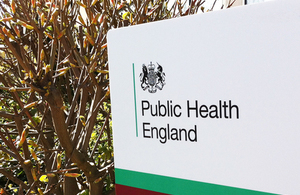PHE urges vigilance in spotting signs of scarlet fever
Public Health England (PHE) advises parents to be aware of scarlet fever symptoms following a substantial rise in reported cases across England in 2017 to 2018.

PHE logo
Latest update
The latest Health Protection Report (13 April 2018) shows 20,372 cases of scarlet fever have been reported since mid-September 2017, compared to an average of 9,461 for the same period over the last 5 years. There were 1,180 cases reported for the most recent week (2 to 8 April 2018).
Dr Nick Phin, Deputy Director of National Infection Service at PHE, said:
We are urging parents to look out for the symptoms of scarlet fever such as a sore throat, fever and rash after seeing a significant upsurge in cases this year. The good news is that over the Easter holidays we have seen a slight decline in cases, which may indicate that activity has peaked.
Scarlet fever, which mainly affects young children, is not usually a serious illness and can be easily treated with the appropriate antibiotics. We encourage parents to contact their GP or NHS 111 if they spot symptoms of scarlet fever or have concerns.
Previous updates
9 March 2018
Scarlet fever is a very contagious, seasonal bacterial illness that mainly affects children and is not uncommon for this time of year.
The latest Health Protection Report (9 March 2018) showed 11,982 cases of scarlet fever have been reported since mid-September 2017, compared to an average of 4,480 for the same period over the last 5 years. There were 1,267 cases reported for the most recent week (12 to 18 February 2018).
This increasing trend is in line with usual patterns although cases are currently higher than those reported at this point in the last 4 seasons. It is not possible at this point to determine what the final numbers will be for this season. Scarlet fever is a clinical diagnosis and not usually confirmed by laboratory testing so the activity we may be seeing could be due to increased awareness and reporting of scarlet fever, although the exact cause is still being investigated.
Scarlet fever is usually a mild illness; PHE is advising parents to be on the lookout for scarlet fever symptoms, which include a sore throat, headache and fever with a characteristic fine, pinkish or red rash with a sandpapery feel. If signs of scarlet fever are suspected, it is important to contact your local GP or NHS 111. Early treatment with antibiotics is important and can help reduce the risk of complications such as pneumonia and the spread of the infection. Children or adults diagnosed with scarlet fever are advised to stay at home until at least 24 hours after the start of antibiotic treatment to avoid spreading the infection to others.
Nick Phin, Deputy Director at Public Health England, said:
It’s not uncommon to see a rise in cases of scarlet fever at this time of year. Scarlet fever is not usually a serious illness and can be treated with antibiotics to reduce the risk of complications and spread to others. We are monitoring the situation closely and remind parents to be aware of the symptoms of scarlet fever and to contact their GP for assessment if they think their child might have it.
Whilst there has been a notable increase in scarlet fever cases when compared to last season, greater awareness and improved reporting practices may have contributed to this increase.
Professor Helen Stokes-Lampard, Chair of the Royal College of GPs, said:
Scarlet fever is a bacterial infection that usually presents with a sore throat, fever, headaches, and a rosy rash that generally starts on a patient’s chest.
It is a very contagious disease and much more common in children under 10 than teenagers or adults, but it can be treated quickly and effectively with a full course of antibiotics and all GPs are trained to diagnose and treat it.
Scarlet fever used to be a lot more common than it is now, but GPs are noticing more cases than in previous years at the moment. If a patient thinks that they, or their child, might have symptoms, they should seek medical assistance.
PHE is also urging GPs, paediatricians, and other health practitioners to be mindful when assessing patients and promptly notify local health protection teams of cases and outbreaks.
For further information on scarlet fever visit the NHS Choices website.
Guidelines for the management of scarlet fever are also available from the PHE website.
6 February 2018
The latest Health Protection Report showed 6,225 cases of scarlet fever had been reported since mid-September 2017, compared to 3,764 for the same period last season. There were 719 cases reported for the most recent week (22 to 28 January 2018).
Updates to this page
-
Added latest update.
-
Updated with latest scarlet fever cases data.
-
First published.